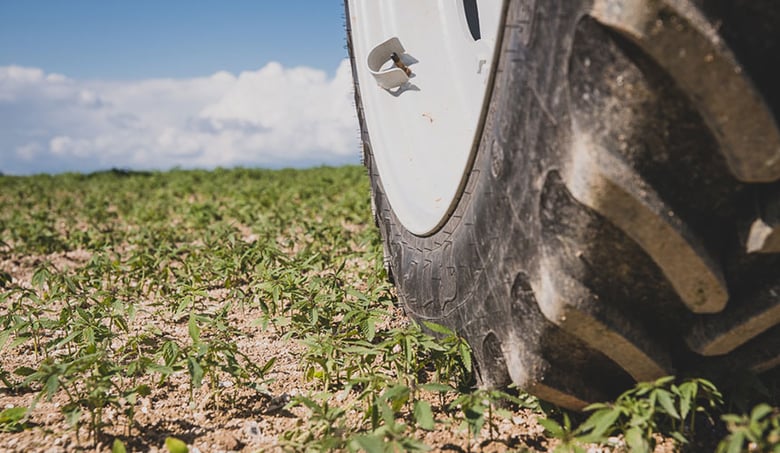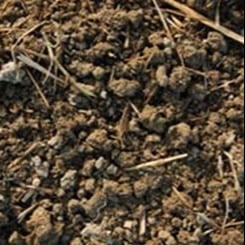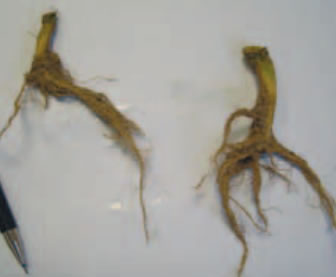Soil is both a substrate for your crops and the driving surface for your agricultural vehicles.
However, crops require aerated soil whereas driving your tractor on soil tends to compact it.
 In order to determine the impact of agricultural vehicles on your plot and, where necessary, to adapt the type and pressure of the tractor tyres used, there are some simple observations that can help you determine the degree of soil compaction.
In order to determine the impact of agricultural vehicles on your plot and, where necessary, to adapt the type and pressure of the tractor tyres used, there are some simple observations that can help you determine the degree of soil compaction.
Soil is a complex mixture of solid material (mineral and organic matter), water, air and living organisms.
The solid components are present in the form of aggregates of various sizes and shapes that, due to the pressure placed upon them by your tractor, are pushed closed and closer together. The distribution of these aggregates determines the soil's structure, and good soil structure is essential for plant growth.
In fact, yield losses due to compaction are roughly 20%, and can even reach 50% in certain cases.

The best soil structure for your crops is a crumbly one, formed of irregular, rounded aggregates that are all separate from each other.

Crumbly soil
This type of structure is porous, thereby facilitating root development, storing water correctly, and providing good aeration to promote biological activity in the soil.
Not all soil types are equal when it comes to compaction. Soil composition, i.e. the size distribution of solid elements (relative proportion of sand, silt and clay), is a determining factor.
You can directly assess the degree of compaction in your soil by identifying its structure. To do this, you simply need to collect clods of earth with a spade, break them up and examine the size and shape of their aggregates. This can also be achieved by performing a soil profile of your land (digging a hole approximately 70 cm deep in your plot).
Another easy method is to measure resistance to penetration using a penetrometer. This device measures the amount of force needed to insert a rod into the soil. The more force required, the more compact the soil.
These measurements should preferably be taken in spring in dry conditions, as the result is influenced by soil moisture.
A number of visible indicators on your crops or the soil surface can give you clues about the state of soil compaction on your plot.
The presence of persistent pools of water on the surface (excluding low points, furrows and superficial run-off zones) is a sign of poor water infiltration due to soil compaction caused by agricultural tyres.
Fewer animals is also a sign of compaction, as there tend to be fewer living organisms (arthropods and earthworms especially) if the soil is compacted.
And finally, if your crops are growing irregularly, it points to differences in soil structure within your plot of land. If there is a marked difference in crop size between where the tractor wheels pass and the rest of the field, or if the ruts are deep, it's likely that your tyres are not well-suited to that particular environment (incorrect tyre pressure, excessive axle load).
Observing root development on your plot can further support your diagnosis. If the roots are well spread out, it means they haven't encountered any obstacles during their growth. However, if the roots are growing at right angles (and there are no solid obstacles like stones in the way), it means they're going around dense zones of overly compacted soil.

In addition to this, if you observe poor germination of your seeds after sowing, the cause may be inadequate soil aeration.
Soil compaction is not necessarily irreversible, and can sometimes be remedied by good overall soil management (using the right cultivation techniques, among others). Adapting your tyres is another vital step towards avoiding further compaction.
The majority of compaction occurs from the first very time you drive your agricultural vehicle over the ground. There are several possible solutions:
To learn more and boost your farm's profits, Bridgestone-agriculture is offering you a free, detailed eBook that explains the essential role your agricultural tyres play in your productivity.
The most people who have read this article have also read the following articles, which are listed below in order of popularity:
This information is intended only to make you aware of the technical and functional aspects of agricultural tires and their use. It does not allow you to make a judgment or a definitive conclusion on a given problem. Only your agricultural tire expert is able to make a technical assessment and take a final decision, case by case.

BRIDGESTONE EUROPE NV/SA
AG Department
Leonardo Da Vincilaan 1
1930 Zaventem | Belgium
Our regional office:
Athena Drive, Tachbrook Park
Warwick CV34 6UX
United Kingdom